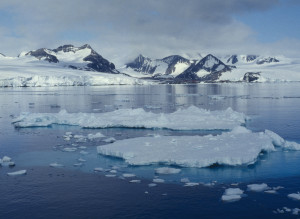Clear skies above but water below, a woman on a moped navigates a flooded street corner on Miami Beach, an all-too-familiar sign for residents of this iconic peninsula where the ocean seems more likely than ever to swamp Ocean Drive one day.
If there's an image that starkly illustrates the threats of climate change, it's this photograph, which was included in the recent National Climate Assessment released by the White House. It is noteworthy because the flood is from exceptionally high spring tides – not heavy rains. Tidal flooding like that is relatively new. And scary. "People in Miami Beach are living climate change," said David Nolan, a meteorology and physical oceanography professor at the University of Miami. "They're on the frontline."
The people of Miami know about climate change. We're living it
Toxic fumes, health concerns remain after L.A. pipeline rupture
Toxic fumes continued to hang in the air at an industrial area of Los Angeles Friday, a day after a pipeline run by a company with a checkered history of accidents ruptured and spilled at least 18,000 gallons of crude oil onto city streets.
“We can smell fumes, but we’re all in today for work,” said an employee at Plumbing and Industrial Supply, a business next door to The Gentleman’s Club, a strip joint that served as the epicenter to the spill and was showered in crude during the rupture in the early hours of Thursday morning.
Big mammals vs. big oil: New pipeline puts humpback whales at risk
In a deep fjord in British Columbia called the Douglas Channel, where the Kitimat River pours runs of Chinook salmon into the Pacific Ocean, fishermen see singing humpback whales fling themselves into the air.
These barnacled, 40-ton whales with long, ridged flippers were harpooned to the brink of extinction in the 1900s. Only through intense conservation efforts have they found safety in ancient migration routes. Mothers birth a single calf in tropical seas and fast for months as it nurses, before migrating thousands of miles up to the North Pacific. There, in enclaves like the Douglas Channel — a critical feeding ground — the whales nourish themselves on krill.
Western Antarctic ice sheet collapse has already begun, scientists warn
 The collapse of the western Antarctic ice sheet is inevitable and is already underway, scientists said on Monday.
The collapse of the western Antarctic ice sheet is inevitable and is already underway, scientists said on Monday.
The melt will cause up to four metres (13 feet) of additional sea-level rise over the coming centuries, devastating low-lying and coastal areas around the world – from Bangladesh to New Jersey – that are already expected to be swamped by only a few feet of sea-level rise.
But the researchers said the sea-level rise – while unstoppable – was still several centuries off, potentially up to 1,000 years away.
Pesticides to blame for honeybee colony collapse disorder, not mites
 Though parasitic mites continue to infect and kill honeybees, a new study suggests they are not to blame for colony collapse disorder (CCD), the phenomenon blamed for rapidly depleting the world's honeybee population -- pesticides are.
Though parasitic mites continue to infect and kill honeybees, a new study suggests they are not to blame for colony collapse disorder (CCD), the phenomenon blamed for rapidly depleting the world's honeybee population -- pesticides are.
Harvard researchers, working with beekeepers in Massachusetts, kept tabs on 18 bee colonies, six hives in three different locations -- from October 2012 to April 2013. Half the colonies were treated with a non-lethal dose of two neonicotinoid pesticides.
Medical experts warn against high levels of radon and radium from fracking
 A group of health professionals opposed to hydraulic fracturing penned a letter Wednesday to Gov. Andrew Cuomo, calling on him to take a closer look at radon levels in shale gas before allowing fracking in New York.
A group of health professionals opposed to hydraulic fracturing penned a letter Wednesday to Gov. Andrew Cuomo, calling on him to take a closer look at radon levels in shale gas before allowing fracking in New York.
The letter, signed by nine people including a representative of the American Lung Association, urges Cuomo’s administration to first examine whether gas from the Marcellus Shale has elevated levels of radon before green-lighting fracking. The state should take a closer look at radiation issues related to shale-gas before proceeding, the letter signers content.
Sentinel satellite spies speed-up of ice cap melting
 Melting at one of the largest ice caps on Earth has produced a big jump in its flow speed, satellite imagery suggests.
Melting at one of the largest ice caps on Earth has produced a big jump in its flow speed, satellite imagery suggests.
Austfonna on Norway's Svalbard archipelago covers just over 8,000 sq km and had been relatively stable for many years. But the latest space data reveals a marked acceleration of the ice in its main outlet glacier to the Barents Sea.
The research was presented in Brussels on Thursday to mark the launch of the EU's new Sentinel-1a radar spacecraft.
New report: Climate change has 'moved firmly into the present' and nation needs to adapt
 Saying that climate change has “moved firmly into the present,” a federal scientific panel Tuesday released a report cataloging the impacts of such changes, saying some would actually be beneficial “but many more are detrimental.”
Saying that climate change has “moved firmly into the present,” a federal scientific panel Tuesday released a report cataloging the impacts of such changes, saying some would actually be beneficial “but many more are detrimental.”
The American Southeast and Caribbean regional is “exceptionally vulnerable” to rising sea levels, extreme heat events, hurricane and decreased water resources, the report said. Seven major ports in the region are vulnerable. And residents can expect a significant increase in the number of hot days – defined as 95 degrees or above – as well as decreases in freezing events.
Oklahoma earthquakes tied to oil, gas work
 The U.S. and Oklahoma Geological Surveys said an increase in earthquakes in the state may be attributed to heightened oil and gas activity.
The U.S. and Oklahoma Geological Surveys said an increase in earthquakes in the state may be attributed to heightened oil and gas activity.
USGS said it examined the rate of increase in earthquakes in Oklahoma and found they weren't due to random fluctuations in seismic activity in that state.
The joint study found injecting wastewater underground can lead to pressure increases that may contribute to earthquakes.
"Much of this wastewater is a byproduct of oil and gas production and is routinely disposed of by injection into wells specifically designed and approved for this purpose," USGS said.
More Articles...
Page 33 of 157

 Environmental News Archive
Environmental News Archive


































